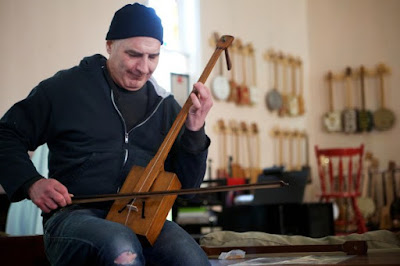
 Sometime back a dealer brought in an odd one stringed instrument that he wanted to fix up and sell. It had some minor finish damage and was missing the bridge and string. But was generally in good condition. He had no background on it and thought it might be a Chinese folk instrument similar to a Erhu.
Sometime back a dealer brought in an odd one stringed instrument that he wanted to fix up and sell. It had some minor finish damage and was missing the bridge and string. But was generally in good condition. He had no background on it and thought it might be a Chinese folk instrument similar to a Erhu. A member on Cigar Box Nation had posted photos of the Instruction Manual. I contacted him in an effort to get more information on the background of the piece and received this in response.
Comment by “Suspect Device”
The only surviving piece I have is an old neck my grandfather built. The box is long gone. I have been promising myself that I am going to build a few of these, based on the "original". Just haven't had the time. This sales brochure and the photographs are the only other info I have. I would love to see a pic of the one you are repairing. - Max
The only surviving piece I have is an old neck my grandfather built. The box is long gone. I have been promising myself that I am going to build a few of these, based on the "original". Just haven't had the time. This sales brochure and the photographs are the only other info I have. I would love to see a pic of the one you are repairing. - Max
Comment by “Suspect Device”
My goodness! Thank you so much for posting these pics! My grandfather actually made that very instrument you have there. This is a really special thing for me to be able to see. The neck looks identical to the one I have. And thanks too for the neck angle info and the rest! That was another detail I have been wondering about. - Max
My goodness! Thank you so much for posting these pics! My grandfather actually made that very instrument you have there. This is a really special thing for me to be able to see. The neck looks identical to the one I have. And thanks too for the neck angle info and the rest! That was another detail I have been wondering about. - Max
At this point it seemed to me that these two needed to be connected permanently so I contacted the dealer and passed along Max's contact information.
I took the Sangtoy to William Harris Lee in downtown Wilmette. It had been along time since I had repaired instruments on a regular a basis and I had no strings or bridges to fit to the instrument. I talked to the head of the shop and discovered we had a mutual quittance in Stan Schmidt who I trained under. While he fit the bridge and attached a 1/2 size cello string I told him the story of the instrument and its new owner. When I asked what I owed him he said "Nothing - Help someone else out some time".
It seemed karmaticly to be the thing to do - so I donated my time as well and packed up the instrument to send off to its new owner.
 Thanks, Rob.
Thanks, Rob.It was my grandfather's tinkering around with these one string fiddles that ultimately led me to building and selling my own primitive stringed instruments. It has been a very rewarding experience and having an original Sangtoy in my possession will kind of bring the whole thing full-circle. My mother is nearing the end of a long battle with dementia, and I often sit with her and play a cigar box guitar I built for her. She still remembers her father playing that one-string fiddle, and it all makes me feel that much closer to her, and to my grandfather. I can't wait to show her the Sangtoy!
I really appreciate the time you have taken to make this happen. Incidentally,
I was surfing around on the internet and found that the Sangtoy was actually patented by my grandfather in 1921. I also found out a bit of info about the company, The Grand Rapids Toy Manufacturing Company, which later became The American Radio Cabinet Company. From what I can put together, my grandfather entered into the business with Robert Brown, a former high school classmate, in 1919. They were basically just kids, barely a year out of Grand Rapids Central High School.
http://kent.migenweb.net/white1924/personal/amerradioco.html
Turns out the new owner is Max Jones. An accomplished and prolific cigar box instrument maker. In looking at his website I found a link to an article about him and his instruments. So glad to see the Sangtoy where it belongs.






























































